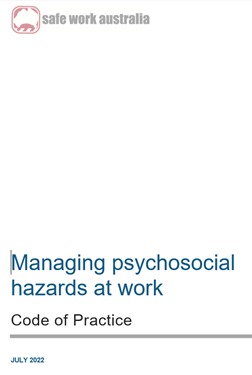 The fixation and psychosis of the safety industry with ‘controls’ and ‘measures’ creates the delusion that psychosocial issues can be controlled and measured.
The fixation and psychosis of the safety industry with ‘controls’ and ‘measures’ creates the delusion that psychosocial issues can be controlled and measured.
When it comes to psychosocial issues, the last thing that helps is quantitative language and simplistic mythology. And the latest Worksafe Code of Practice on Managing Psychosocial Hazards at Work exemplifies the problem.
Download the Code of Practice here: model code of practice – managing psychosocial hazards at work
Let’s start with an easy one, stress (p.6).
‘Stress is the body’s reaction when a worker perceives the demands of their work exceed their ability or resources to cope’.
Just look at the language. Stress is contingent on the perception of the worker who is stressed. Of course, if I ‘feel’ stressed and declare that stress, how will this be measured? How are admissions of stress usually received? When is it ever confessed? Indeed, how will stress be managed to as low as reasonably practicable (ALARP). Four subjectivities nicely strung together here: stress, feeling, perception and ALARP. Safety is already out of its depth. There is no discussion on the challenges of subjectivity or bias in this document.
In an industry that adores counting numbers, engineering, blame and bullying, who would ever admit they are suffering from stress? Indeed, with a regulator who adores inquisitions, blitzes and ‘we’ll get you’ rhetoric, who is going to talk to Safety about stress? It’s like R U OK day on steroids. Put out a code without a method and nothing changes.
So, even if a worker approaches management and says they are stressed, are they believed? Not likely, this is Safety. Indeed, with what expertise will a safety person help enact this code of practice with the curriculum and industry infused with Behaviourism? How can the ‘quanta’ of Behaviourism understand the ‘qualia’ of psycho-social need?
I called for curriculum reform in safety 7 year ago (https://safetyrisk.net/isnt-it-time-we-reformed-the-whs-curriculum/ ) and nothing. I guess even if one day there was a review of the WHS curriculum they would get an engineer to do it. Unless Safety moves away from zero ideology, Behaviourism and binary discourse, nothing will improve when it comes to psychological injury.
Indeed, it is well known that BBS and Zero (the love children of Safety) are principle contributors to the dehumanization, brutalism and psychological abuse of persons. Any absolute placed on fallible people can only result in brutalism, such is the vice of zero and an industry with no ethic.
So, whilst it is good to have a code of practice on these matters where is the discussion at the heart of the problem that is: the way the safety industry cultivates psychological and social harm? No mention of such in this document.
When you see humans and speak about people as ‘factors’ or ‘components’ in a system they have already been dehumanized and devalued. When one understands culture as a ‘product’, behaviours or systems, the real underlying problems to do with psychosocial injury will remain untouched.
Naturally, there is no mention of BBS, Zero or dehumanization in this document. This makes it wonderfully aligned with the AIHS BoK Chapter on Ethics that never mentions personhood, power, zero, BBS or a host of unethical things that safety normalizes and adores in its pursuit of counting objects, hazards and controls.
I wonder on what skill base this Code of Practice expects enactment? Into what depths of skill will safety people be able to delve to communicate about mental illness? Considering safety people are given no basic training in communication, listening, engagement, helping or pastoral care, where will a response emerge from?
I was sent this document yesterday from an observer on LinkedIn packaged as a proud descriptor of what safety people do (Figure One. Safety Responsibilities)
Figure One. Safety Responsibilities
Looks very authentic to me and something that could have been taken out of any safety HR document anywhere. Indeed, most in safety would probably agree that this is what Safety does.
The glaring omission is? You guessed it, people. Simple things like care, helping skills (no mention in this document), listening (no mention in this document), understanding, empathy (no mention in this document), counselling etc. all skills necessary in tackling psychological injury, social and mental health issues, crickets! None of this is mentioned across the safety industry, such is its identity and self-understanding.
How is an industry in love with objects ever going to learn how to engage with subjects? How is an industry framed by the love of zero (https://www.humandymensions.com/product/for-the-love-of-zero-free-download/ ), defined by a number, ever going to be able to focus on persons?
There is no compatibility between the ideology of zero and this document on psychosocial issues. Zero begins, ends and is defined by intolerance. The greatest need anyone has with a psychosocial injury is tolerance.
So, put out a Code of Practice but where is the skill development in the WHS curriculum to help safety people enact the demands of this Code?
Where is the understanding of culture needed to enact the concerns of this document?
When Safety is silent (https://safetyrisk.net/category/safety-culture-silences/ ) on so many critical factors in culture, how is it going to evaluate cultural issues that engender psychosocial harm?




Do you have any thoughts? Please share them below